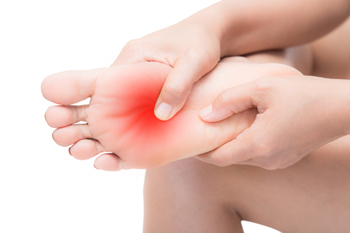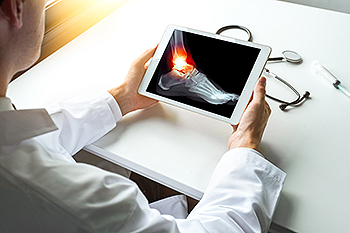Items filtered by date: November 2024
Understanding How Neuropathy Affects the Feet

Neuropathy in the feet refers to nerve damage that affects sensation, movement, and function. This condition can lead to various symptoms, making everyday activities more challenging. One of the most noticeable signs is a change in the appearance of the toenails and skin. The toenails may become thick, discolored, or brittle, while the skin might appear dry or overly sensitive. Weakening of the foot muscles is another common symptom, leading to difficulty with walking or standing for extended periods. People with neuropathy may also experience a loss of balance, which increases the risk of falls. Sensations like burning, tingling, or numbness in the feet are frequent as well, often causing discomfort or pain. If you are experiencing any of the above symptoms, it is suggested that you promptly consult a podiatrist who can offer you effective relief and management strategies.
Neuropathy
Neuropathy can be a potentially serious condition, especially if it is left undiagnosed. If you have any concerns that you may be experiencing nerve loss in your feet, consult with one of our podiatrists from Family Foot Health Center. Our doctors will assess your condition and provide you with quality foot and ankle treatment for neuropathy.
What Is Neuropathy?
Neuropathy is a condition that leads to damage to the nerves in the body. Peripheral neuropathy, or neuropathy that affects your peripheral nervous system, usually occurs in the feet. Neuropathy can be triggered by a number of different causes. Such causes include diabetes, infections, cancers, disorders, and toxic substances.
Symptoms of Neuropathy Include:
- Numbness
- Sensation loss
- Prickling and tingling sensations
- Throbbing, freezing, burning pains
- Muscle weakness
Those with diabetes are at serious risk due to being unable to feel an ulcer on their feet. Diabetics usually also suffer from poor blood circulation. This can lead to the wound not healing, infections occurring, and the limb may have to be amputated.
Treatment
To treat neuropathy in the foot, podiatrists will first diagnose the cause of the neuropathy. Figuring out the underlying cause of the neuropathy will allow the podiatrist to prescribe the best treatment, whether it be caused by diabetes, toxic substance exposure, infection, etc. If the nerve has not died, then it’s possible that sensation may be able to return to the foot.
Pain medication may be issued for pain. Electrical nerve stimulation can be used to stimulate nerves. If the neuropathy is caused from pressure on the nerves, then surgery may be necessary.
If you have any questions, please feel free to contact our office located in Rogers and Berryville, AR . We offer the newest diagnostic and treatment technologies for all your foot care needs.
Saving Limbs With Diabetic Foot Care

Poor diabetic foot care can lead to serious complications, including infections, ulcers, and even amputations. Individuals with diabetes often experience reduced blood flow and nerve damage, which can mask injuries and make it difficult to detect problems early. When wounds are left untreated, they can quickly become infected, leading to more severe health issues. Proper diabetic foot care is essential in preventing these complications and can significantly reduce the risk of limb loss. Regularly inspecting the feet for cuts, blisters, or changes in color, along with maintaining good hygiene and wearing appropriate footwear, can help identify potential problems early. If you have diabetes, it is strongly suggested that you are under the care of a podiatrist who can help you to manage this serious condition.
Diabetic foot care is important in preventing foot ailments such as ulcers. If you are suffering from diabetes or have any other concerns about your feet, contact one of our podiatrists from Family Foot Health Center. Our doctors can provide the care you need to keep you pain-free and on your feet.
Diabetic Foot Care
Diabetes affects millions of people every year. The condition can damage blood vessels in many parts of the body, especially the feet. Because of this, taking care of your feet is essential if you have diabetes, and having a podiatrist help monitor your foot health is highly recommended.
The Importance of Caring for Your Feet
- Routinely inspect your feet for bruises or sores.
- Wear socks that fit your feet comfortably.
- Wear comfortable shoes that provide adequate support.
Patients with diabetes should have their doctor monitor their blood levels, as blood sugar levels play such a huge role in diabetic care. Monitoring these levels on a regular basis is highly advised.
It is always best to inform your healthcare professional of any concerns you may have regarding your feet, especially for diabetic patients. Early treatment and routine foot examinations are keys to maintaining proper health, especially because severe complications can arise if proper treatment is not applied.
If you have any questions please feel free to contact our office located in Rogers and Berryville, AR . We offer the newest diagnostic and treatment technologies for all your foot and ankle needs.
Achilles Tendonitis and Achilles Tendinosis

Achilles tendonitis and Achilles tendinosis are two distinct conditions affecting the Achilles tendon, each with different characteristics and causes. Achilles tendonitis is an acute inflammation of the tendon, often resulting from overuse or sudden increases in physical activity. Common symptoms include pain, swelling, and stiffness, particularly during movement. On the other hand, Achilles tendinosis refers to a chronic degeneration of the tendon due to prolonged stress and lack of proper healing. This condition often causes persistent pain and stiffness, especially in the morning or after periods of inactivity. Causes of both conditions include repetitive strain from sports, improper footwear, and biomechanical issues like flat feet or high arches. If you have developed an Achilles tendon injury, it is suggested that you consult a podiatrist who can guide you toward the right treatment solutions for the type of condition you have.
Achilles tendon injuries need immediate attention to avoid future complications. If you have any concerns, contact one of our podiatrists of Family Foot Health Center. Our doctors can provide the care you need to keep you pain-free and on your feet.
What Is the Achilles Tendon?
The Achilles tendon is a tendon that connects the lower leg muscles and calf to the heel of the foot. It is the strongest tendon in the human body and is essential for making movement possible. Because this tendon is such an integral part of the body, any injuries to it can create immense difficulties and should immediately be presented to a doctor.
What Are the Symptoms of an Achilles Tendon Injury?
There are various types of injuries that can affect the Achilles tendon. The two most common injuries are Achilles tendinitis and ruptures of the tendon.
Achilles Tendinitis Symptoms
- Inflammation
- Dull to severe pain
- Increased blood flow to the tendon
- Thickening of the tendon
Rupture Symptoms
- Extreme pain and swelling in the foot
- Total immobility
Treatment and Prevention
Achilles tendon injuries are diagnosed by a thorough physical evaluation, which can include an MRI. Treatment involves rest, physical therapy, and in some cases, surgery. However, various preventative measures can be taken to avoid these injuries, such as:
- Thorough stretching of the tendon before and after exercise
- Strengthening exercises like calf raises, squats, leg curls, leg extensions, leg raises, lunges, and leg presses
If you have any questions please feel free to contact our office located in Rogers and Berryville, AR . We offer the newest diagnostic tools and technology to treat your foot and ankle needs.
What Is a Trimalleolar Fracture?

A trimalleolar fracture refers to a specific type of ankle injury that involves three distinct bony structures. It typically includes fractures of the lateral malleolus, medial malleolus, and the posterior malleolus of the tibia. This injury often occurs due to high-impact trauma, such as falling from a height or a severe twisting motion of the ankle. The resulting instability of the ankle joint can lead to significant pain, swelling, and difficulty in bearing weight. Diagnosis is typically confirmed through imaging studies like X-rays or CT scans, which reveal the extent of the fractures. Treatment often requires surgery to realign the fractured bones and stabilize the joint. If you have fractured your ankle, it is suggested that you consult a podiatrist who can accurately diagnose and treat this injury.
Broken ankles need immediate treatment. If you are seeking treatment, contact one of our podiatrists from Family Foot Health Center. Our doctors can provide the care you need to keep you pain-free and on your feet.
Broken Ankles
A broken ankle is experienced when a person fractures their tibia or fibula in the lower leg and ankle area. Both of these bones are attached at the bottom of the leg and combine to form what we know to be our ankle.
When a physician is referring to a break of the ankle, he or she is usually referring to a break in the area where the tibia and fibula are joined to create our ankle joint. Ankles are more prone to fractures because the ankle is an area that suffers a lot of pressure and stress. There are some obvious signs when a person experiences a fractured ankle, and the following symptoms may be present.
Symptoms of a Fractured Ankle
- Excessive pain when the area is touched or when any pressure is placed on the ankle
- Swelling around the area
- Bruising of the area
- Area appears to be deformed
If you suspect an ankle fracture, it is recommended to seek treatment as soon as possible. The sooner you have your podiatrist diagnose the fracture, the quicker you’ll be on the way towards recovery.
If you have any questions, please feel free to contact our office located in Rogers and Berryville, AR . We offer the newest diagnostic and treatment technologies for all your foot care needs.

